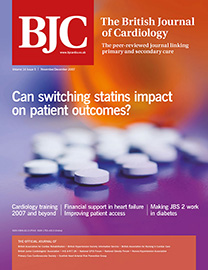Editorials
Clinical articles
News and views
Topics include:-
- Can switching statins impact on patient outcomes?
- Cardiology training – 2007 and beyond
- Financial support in heart failure – improving patient access
- Making JBS 2 work in diabetes
November 2007 Br J Cardiol 2007;14:251-2
Terry McCormack, Rubin Minhas
Abstract

Switching statins from on-patent to off-patent generic simvastatin is currently the focus of a major policy initiative by the Department of Health. In this context, an observational study of statin switching conducted by the manufacturer of an on-patent statin has already attracted considerable widespread media attention even before its publication within this issue of the British Journal of Cardiology (see pages 280-5). It is likely to stimulate considerable controversy and debate in the months ahead.
|
Full text
Clinical articles
Back to top
November 2007 Br J Cardiol 2007;14:255-9
BJCardio editorial team
Abstract

Major new trials reported at the American Heart Association 2007 Scientific Sessions, held in Orlando, Florida, US, on November 3rd–7th, showed mixed results for the new antiplatelet agent, prasugrel, and gave renewed hope for the high-density lipoprotein raising field. But there was disappointment regarding the use of statins in heart failure and beta blockers in general surgery.
|
Full text
November 2007 Br J Cardiol 2007;14:265
Jonathan M Behar, Thomas R Burchell, Ben Adeyemi, Fiona Myint
Abstract

A 78-year-old woman presented to the vascular surgeons for a routine varicose vein procedure. She was fit and well with no significant medical history and had no cardiovascular risk factors. Clinically she was asymptomatic with a good excercise tolerance and no signs of heart failure. During the pre-operative assessment, a loud systolic murmur was heard all over the precordium with greatest intensity at the upper left sternal edge. Her electrocardiogram was unremarkable. A subsequent two-dimensional echocardiogram revealed a dilated aortic root and a large, 6.6cm aneurysm of the right coronary sinus of valsalva (see figure 1), which extended into the right ventricular outflow tract causing obstruction with an associated gradient of 44 mmHg. Her right ventricle was hypertrophied and there was mild tricuspid regurgitation. Her left ventricular function was normal and there was evidence of mild aortic regurgitation. A cardiothoracic opinion was sought but the operative risks were deemed unacceptable to both the surgeon and patient.
|
Full text
November 2007 Br J Cardiol 2007;14:267-71
James D Lee, Sakera Shaikh, John R Morrissey, Vinod Patel
Abstract

Patients with diabetes are at particularly high risk for cardiovascular disease. Indeed diabetes has been appropriately described as ‘a state of premature cardiovascular death associated with chronic hyperglycaemia’.1 Recently, the European Society of Cardiology (ESC) and the European Association for the Study of Diabetes (EASD) have published joint guidelines on diabetes, pre-diabetes, and cardiovascular diseases.2 Broadly, they reflect the rigorous approach of the 2005 revised Joint British Societies’ guidelines on the Prevention of Cardiovascular Disease in Clinical Practice (JBS 2).3 In this article, we will revisit the main JBS 2 guidelines for individuals with diabetes and compare them with the recommendations from the ESC/EASD.
|
Full text
November 2007 Br J Cardiol 2007;14:275-79
Christopher Ward
Abstract

Many heart failure patients are eligible to receive financial support (Disability Living Allowance or Attendance Allowance) because of their impaired mobility. Those with a very limited prognosis can gain rapid access to these benefits by claiming under "special rules" with the support of a report (DS 1500) from their doctor.
|
Full text
November 2007 Br J Cardiol 2007;14:280-5
Berkeley Phillips, Fayaz Aziz, Christopher P O"Regan, Craig Roberts, Amy E Rudolph, Steve Morant
Abstract

Little is currently known of the effect of switching statin therapy on cardiovascular outcomes. Using The Health Improvement Network database, patients who had received atorvastatin for ≥ six months were identified. They were classified as ‘switch’ if they were subsequently switched to simvastatin, and were matched to up to four 'control' patients who remained on atorastatin. Time to death or first major cardiovascular event was compared, controlling for the matching co-variates, prior statin exposure and baseline cholesterol concentration.
|
Full text
November 2007 Br J Cardiol 2007;14:286-8
Chris Gale, Helen Simpson, Saul Myerson, Nick Curzen, Theresa McDonagh, Ian Wilson, Peter Mills, James Hall, Stuart Cobbe
Abstract

Implementation of a new specialty training Curriculum in Cardiology from August 2007 will bring significant changes to specialist training in cardiology. The format, delivery and evaluation will differ, and these changes are relevant to both existing and newly appointed trainees. This article aims to summarise the changes and incorporates presentations by the Cardiology Specialist Advisory Committee at the British Cardiovascular Society conference in June 2007.
|
Full text
November 2007 Br J Cardiol 2007;14:289-92
Ariel Roguin, Prashant Nair
Abstract

Several imaging modalities are available for the optimal management of patients with cardiovascular disease. When assessing any imaging technique, the radiation dose must be considered along with the value of the imaging technique. In this article, we summarise the radiation doses associated with cardiovascular imaging techniques, such as heart catheterisation, nuclear medicine and multi-slice computed tomography. The effective dose of the dual isotope scan, an image modality frequently used in cardiac patients, is higher (~25 mSv) than cardiac computed tomography (~10 mSv) or diagnostic heart catheterisation (~5 mSv). The physician should weigh carefully which test to recommend in each patient.
|
Full text
November 2007 Br J Cardiol 2007;14:296
Sushma Rekhraj, Trevor Wistow
Abstract

This case describes the unfortunate consequence of hepatic abscess, initially discovered following abnormal liver function tests.
|
Full text
September 2007 Br J Cardiol 2007;14:293-95
Peter O’Kane, Lucy Blows, Simon Redwood
Abstract

The presence of severe vessel tortuosity, extreme angulation of side-branch ostia, stent jail, or lack of control at the interface of chronic total occlusions can result in percutaneous coronary intervention failure or complications. The Venture™ wire control catheter is a new catheter system designed to facilitate tip direction of a standard 0.014” guidewire. The properties of this system are discussed in this article along with an example of its use in practice.
|
Full text
News and views
Back to top


